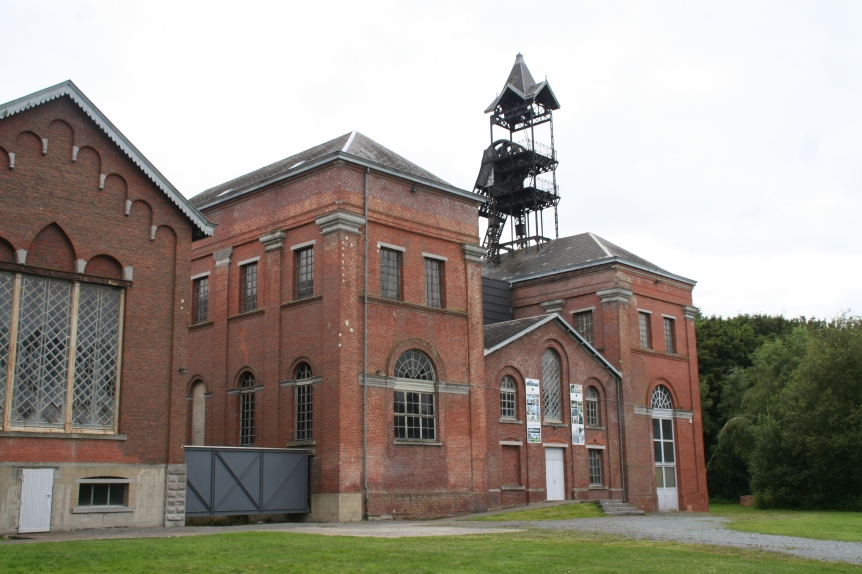Having visited the Bois du Cazier a few months back (see our review here), the next stop on Pangloss’ impromptu tour of Belgian coal mines was the Bois du Luc, located in Houdeng-Aimeries (La Louvière). Together with the Bois du Cazier, Blegny-mine and Grand-Hornu, the Bois du Luc is one of the preserved sites which form a UNESCO world heritage site. The Bois du Luc is probably the largest and most historically interesting of these sites, covering the technical, management and social history aspects of mining in Belgium during the 19th and early 20th centuries.

The Bois du Luc site is quite self-contained and located some distance from the rest of the little suburb of Houdeng-Aimeries. For most of its history, the site was the headquarters of the Société des Charbonnages de Bois-du-Luc et d’Havré, as well as the site of one of its actual mines known as the Fosse (“Pit”) St-Emmanuel. Surrounding this, the company built a kind of housing estate (known as Bosquetville) for its workers, including all the social amenities necessary as well as the actual housing itself.
To order to make the situation a bit clearer, Pangloss has drawn up a quick (and pretty basic) map. In red and green are the buildings of the company: the offices, workshops and, of course, the mine itself; in orange is the director’s house; in blue, the workers’ housing (dating from 1838) radiating out from a central street; in yellow are the community buildings: the school, theatre, church and hospital. Some of the industrial buildings have been destroyed (since the Foss St-Emmanuel closed in 1959, this is hardly surprising) but the whole site is still pretty near complete.
What is so interesting about all of this is that it provides a fantastic glimpse into the idea of industrial paternalism in 19th century Belgium. Paternalism was, of course, an ideology shared by both Catholic and Liberal industrialists, both of whom felt that the rich had a moral duty to improve the conditions of their workers. In the Bois du Luc, this meant that pretty far reaching attempts were made to improve the lot of the company’s employees – or, at least, the virtuous, married and Catholic, employees. In exchange for genuine improvements in quality of life, the workers were expected to give the patron – the boss – even more respect and unquestioning obedience. From the balcony of his house facing down the main road, the patron could survey his workers while the workers were left in no doubt as to where power lay.
Behind the monumental steel doors (installed after the general strike of 1893), the mining offices – a monumental building decorated with a neoclassical interior – are perhaps the most interesting bit. Everything relates to the social hierarchy, from the mirrors in the patron’s office to allow him to screen visitors without their knowledge to the toilet (one of three on the whole site!) that was reserved for his personal use. The employees (one rung up from the miners themselves on the social hierarchy) had their toilet breaks timed so that they could be made to make up for them after work.

The Bois du Luc museum has, to its great credit, done a lot to make this complex story clear to visitors. There are basically four elements to the tour which the museum runs. Starting at the company offices, the tour then moves to one of the workers’ houses which you can visit (the rest are inhabited) and finally to the mine itself. There is also a small museum of the history of coal-mining in the old workshops which the visitor is invited to visit at their leisure. It must be said that the tour is very good. Our guide was knowledgeable and it was pretty definitive. The whole visit lasted a bit over three hours (which is pretty impressive) and was genuinely instructive. There is obviously also the opportunity to wander out and see the workers’ housing in more detail on your own.
Pangloss thoroughly recommends a visit. However, it is definitely worth checking the museum’s (awful) website before you visit – the museum is closed for most of the year. The miners’ church, St Barbara, is only open on a handful of weekends throughout the year and Pangloss did not get a chance to see it. A final thing for visitors to note is that, because the only way to visit the site is on a guided tour, there is a potential difficulty for non-French speakers.
The museum’s website can be found here.





















